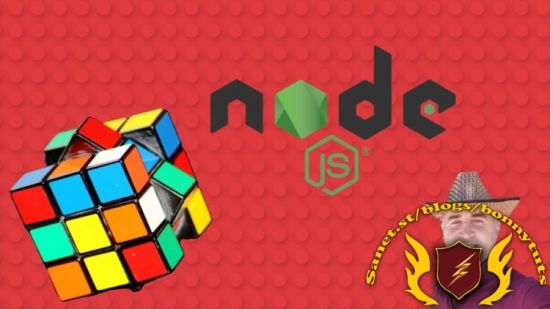
Published 9/2024
Created by Ahmet Bilgic
MP4 | Video: h264, 1280×720 | Audio: AAC, 44.1 KHz, 2 Ch
Genre: eLearning | Language: English | Duration: 10 Lectures ( 42m ) | Size: 638 MB
Your Step-by-Step Guide to Becoming a Node.js Expert
What you’ll learn:
NodeJs Magic: Event-Driven Architecture
Create powerful apps using Nodejs essentials like HTTP servers, file systems, paths, and event emitters.
Master the Toolbox: Install, manage, and update packages effortlessly with npm.
Callbacks, Promises, and Beyond: Unlock the secrets of asynchronous programming with Nodejs.
Requirements:
Familiarity with basic programming concepts like variables, loops, and functions will be helpful.
A fundamental grasp of JavaScript is recommended since Nodejs is built on it.
Description:
1. NodeJS ArchitectureEvent-Driven Architecture: Understanding how NodeJS handles asynchronous operations using an event loop.Single Threaded Nature: Learn how NodeJS manages multiple tasks concurrently despite being single-threaded.Non-blocking I/O: How NodeJS uses non-blocking I/O operations to handle multiple requests efficiently.2. Core ModulesHTTP Module: Creating HTTP servers, handling requests and responses.File System (fs) Module: Reading and writing files, managing directories.Path Module: Working with file and directory paths.Events Module: Creating and handling custom events.Stream Module: Handling large data sets by processing data in chunks.OS Module: Interacting with the operating system, gathering system information.Util Module: Utility functions, including deprecating methods and debugging.3. npm (Node Package Manager)Package Management: Installing, updating, and removing packages.Creating and Publishing Packages: Building your own NodeJS packages and publishing them to npm.Semantic Versioning: Understanding versioning in npm and how to use it.4. Asynchronous ProgrammingCallbacks: The foundation of async programming in NodeJS.Promises: Handling asynchronous operations more elegantly with .then() and .catch().Async/Await: Writing asynchronous code that looks synchronous for better readability.Event Loop: In-depth understanding of how the event loop processes asynchronous callbacks.Timers: Using setTimeout, setInterval, and setImmediate.5. Express.js FrameworkSetting Up a Server: Creating a basic server with Express.Routing: Defining routes for handling HTTP requests.Middleware: Implementing and understanding the role of middleware in request processing.Error Handling: Centralized error handling in Express applications.Template Engines: Using engines like EJS, Pug, or Handlebars to render dynamic content.6. Web APIs and RESTful ServicesCreating REST APIs: Building RESTful services with Express.js or other frameworks.CRUD Operations: Implementing Create, Read, Update, Delete operations in your API.Authentication: Securing APIs with JWT (JSON Web Tokens), OAuth, or other authentication methods.API Documentation: Using tools like Swagger to document your API.7. Database IntegrationSQL Databases: Using libraries like pg for PostgreSQL or mysql2 for MySQL.NoSQL Databases: Integrating with MongoDB using Mongoose.ORMs: Working with ORMs like Sequelize for SQL databases.Database Migrations: Managing database schema changes with migration tools.8. Real-time ApplicationsWebSockets: Using libraries like socketIO to build real-time applications like chat apps.Server-Sent Events (SSE): Implementing unidirectional server-to-client updates.Polling: Understanding long polling as an alternative to WebSockets.9. SecurityData Validation: Ensuring incoming data is valid and secure using libraries like Joi.Input Sanitization: Preventing injection attacks by sanitizing input.Authentication and Authorization: Implementing secure authentication mechanisms.HTTPS: Securing your NodeJS server with HTTPS.Rate Limiting: Protecting your APIs from brute-force attacks with rate limiting.10. TestingUnit Testing: Writing tests for individual units of code using frameworks like Mocha, Jest, or Jasmine.Integration Testing: Testing the interaction between different parts of your application.Test-Driven Development (TDD): Writing tests before code to ensure functionality.Mocking and Stubbing: Simulating external services or functions in tests.11. Deployment and ScalingEnvironment Management: Using .env files and environment variables for configuration.Process Management: Using PM2 or forever to manage NodeJS processes in production.Load Balancing: Distributing traffic across multiple instances of your application.Scaling: Horizontal and vertical scaling techniques for NodeJS applications.Containerization: Using Docker to containerize your NodeJS application.CI/CD Pipelines: Automating the deployment process using tools like Jenkins, GitHub Actions, or CircleCI.12. Working with Streams and BuffersReadable and Writable Streams: Understanding how to process data piece by piece.Pipes: Connecting streams together to pass data from one stream to another.Transform Streams: Manipulating data as it is read or written.Buffers: Handling binary data directly in NodeJS.13. Error Handling and DebuggingError Handling Best Practices: Using try…catch and centralized error handling middleware.Logging: Implementing logging using libraries like Winston or Bunyan.Debugging: Using NodeJS built-in debugger or Chrome DevTools for debugging.14. Build Tools and Task RunnersGulp: Automating tasks like minification, compilation, and linting.Webpack: Module bundler for handling project assets.ESLint: Enforcing coding standards and style guidelines.15. Microservices and API GatewaysMicroservice Architecture: Designing and implementing microservices with NodeJS.API Gateway: Managing multiple microservices behind a unified interface using tools like YARP or NGINX.Inter-service Communication: Using protocols like HTTP, gRPC, or message queues.16. Performance OptimizationProfiling: Using tools like NodeJS Profiler and Clinic.js to identify performance bottlenecks.Caching: Implementing caching strategies with Redis or in-memory caches.Clustering: Utilizing NodeJS’s clustering module to take advantage of multi-core systems.17. Advanced TopicsChild Processes: Running multiple processes from a single NodeJS script.Worker Threads: Leveraging multi-threading in NodeJS for CPU-intensive tasks.Serverless: Deploying NodeJS applications in a serverless architecture using AWS Lambda, Google Cloud Functions, etc.
Password/解压密码www.tbtos.com
转载请注明:0daytown » Mastering Node.js: From Beginner to Backend Pro